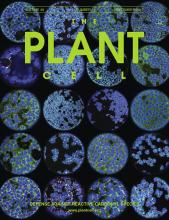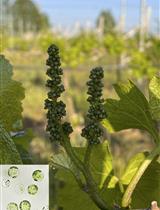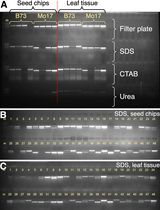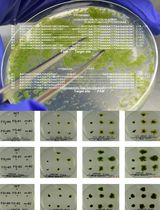- EN - English
- CN - 中文
Genome-wide Estimation of Evolutionary Distance and Phylogenetic Analysis of Homologous Genes
进化距离的全基因组评估和同源基因的系统进化分析
发布: 2018年12月05日第8卷第23期 DOI: 10.21769/BioProtoc.3097 浏览次数: 7927
评审: Chen ChenAnonymous reviewer(s)
Abstract
Homologous genes, including paralogs and orthologs, are genes that share sequence homologies within or between different species. Homologous genes originate from a common origin through speciation, genetic duplication or horizontal gene transfer. Estimation of the sequence divergence of homologous genes help us to understand divergence time, which makes it possible to understand the evolutionary patterns of speciation, gene duplication and gene transfer events. This protocol will provide a detailed bioinformatics pipeline on how to identify the homologous genes, compare their sequence divergence and phylogenetic relationships, focusing on homologous genes that show syntenic relationships using soybean (Glycine max) and common bean (Phaseolus vulgaris) as example species.
Keywords: Homologous genes (同源基因)Background
Gene duplication, including whole genome duplication or polyploidy, segmental duplication, and tandem duplication, is a very important process that increases gene copy number and thus enhances genetic diversity in many organisms. Because of this, gene duplication is thought to be a major force in evolution (Ohno, 1970; Otto and Whitton, 2000; Blanc and Wolfe, 2004; Jiao et al., 2011). After duplication, duplicated genes are subject to a variety of changes, such as accumulation of point mutations, insertions and deletions, gene conversion and transposon insertions (Ilic et al., 2003; Gu et al., 2005; Sémon and Wolfe, 2007). Theoretically, two or multiple copies of the duplicated genes have undergone different levels of selective constraint, which makes the functional divergence of the duplicated genes. This can be reflected on the sequence divergence of the homologous genes, such as non-synonymous substitution (Ka) and synonymous substitution (Ks), the latter of which the produced amino acid sequence is not modified. Because it is neutral with respect to selection, Ks can be used to determine rough divergence time. The ratio of Ka/Ks can be used to estimate the selection pressure on genes. A Ka/Ks ratio equal to one indicates a lack of selection, as is observed in pseudogenes. The ratio of Ka/Ks higher and lower than one implies positive and purifying selection, respectively. The values of Ka/Ks for the vast majority of genes are < 1.0 due to purifying selection to maintain function (Makalowski and Boguski, 1998; Nekrutenko et al., 2002). When comparing duplicate genes, differences in Ka/Ks suggest different levels or kinds of selection.
In order to determine the evolutionary distance, we first need to identify the homologous genes within or between different species. Here, we will mainly focus on the homologous genes that show syntenic relationships between different species. Syntenic genes are those genes that retain an ancestral position on a given region of a chromosome. We refer to these syntenic homologous genes as “syntelogs” (Zhao et al., 2017). The advantage of focusing on syntelogs is that if they are the result of polyploidy, all syntelogs arose at the same time, so groups of syntenic gene pairs can be compared with high confidence. Here, we describe a detailed pipeline for the identification and comparison of the evolutionary distance of syntelogs by using soybean (Glycine max) and common bean (Phaseolus vulgaris) as example species (Figure 1). It has been proposed that soybean has experienced a recent whole genome duplication event roughly 5 to 13 million years ago (MYA, Schmutz et al., 2010), occurring after the split with its close relative common bean roughly 19 MYA (Lavin et al., 2005; McClean et al., 2010). In this protocol, we will estimate the evolutionary divergence of the duplicated gene pairs in soybean by comparing them with the orthologous genes in the common bean genome.
Equipment
- Linux/Unix cluster
In this study, we use the Purdue Halstead supercomputer, which contains 508 nodes in total. Each node contains 20 cores, two 10-Core Intel Xeon-E5 processors, and 128 GB memory. Please refer to the website for more information: https://www.rcac.purdue.edu/compute/halstead. - Personal computer for post data processing (Lenovo, T430s, Intel Core i5-3320M CPU, 4 GB RAM)
Software
- Blastall or Blast+ (Altschul et al., 1997)
https://blast.ncbi.nlm.nih.gov/Blast.cgi?PAGE_TYPE=BlastDocs&DOC_TYPE=Download
This program is developed and distributed by NCBI to do blast searches. - MCScanX (Wang et al., 2012), http://chibba.pgml.uga.edu/mcscan2/
This toolkit is for detection and evolutionary analysis of gene synteny and collinearity. This program also can generate tandemly duplicated genes. - Multiple Sequence Comparison by Log-Expectation (MUSCLE) (Edgar, 2004), https://www.drive5.com/muscle/
- ClustalW (Thompson et al., 1994), http://www.clustal.org/clustal2/
Both Muscle and ClustalW are software for multiple sequence alignment for nucleotide and protein sequences. - Phylogenetic Analysis by Maximum Likelihood (PAML) (Yang et al., 2007), http://abacus.gene.ucl.ac.uk/software/paml.html
PAML is a package of programs for phylogenetic analyses of DNA or protein sequences using maximum likelihood. - Molecular Evolutionary Genetics Analysis (MEGA X) (Kumar et al., 2018), https://www.megasoftware.net/
This software contains many sophisticated methods and tools for phylogenetic analysis, including constructing phylogenetic trees as well as evolutionary distance estimation. - Perl, https://www.perl.org/, or Python, https://www.python.org/, programming languages
These languages make it possible to post-process the primary data generated from some of the software used above. - SAS software, https://www.sas.com/en_us/home.html
SAS is a software for statistical analysis.
Procedure
文章信息
版权信息
© 2018 The Authors; exclusive licensee Bio-protocol LLC.
如何引用
Zhao, M., Zhang, B., Ma, J. and Lisch, D. (2018). Genome-wide Estimation of Evolutionary Distance and Phylogenetic Analysis of Homologous Genes. Bio-protocol 8(23): e3097. DOI: 10.21769/BioProtoc.3097.
分类
植物科学 > 植物分子生物学 > 遗传分析
系统生物学 > 基因组学 > 种系遗传学
您对这篇实验方法有问题吗?
在此处发布您的问题,我们将邀请本文作者来回答。同时,我们会将您的问题发布到Bio-protocol Exchange,以便寻求社区成员的帮助。
Share
Bluesky
X
Copy link














